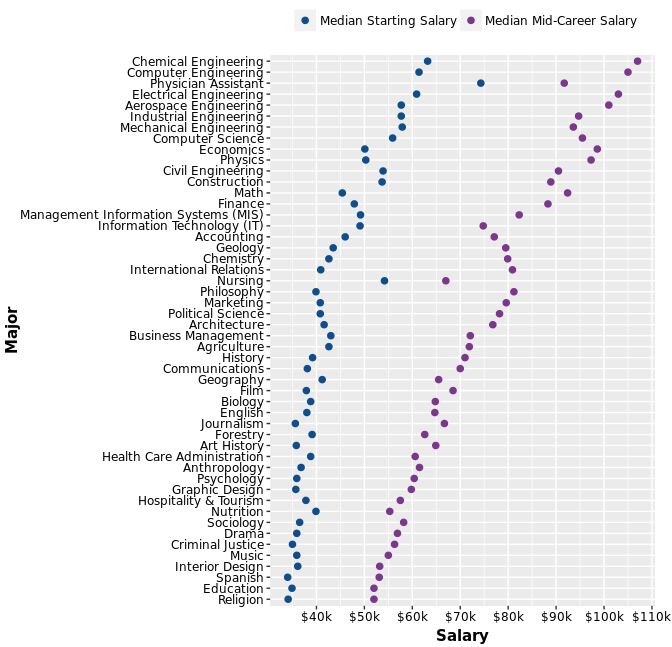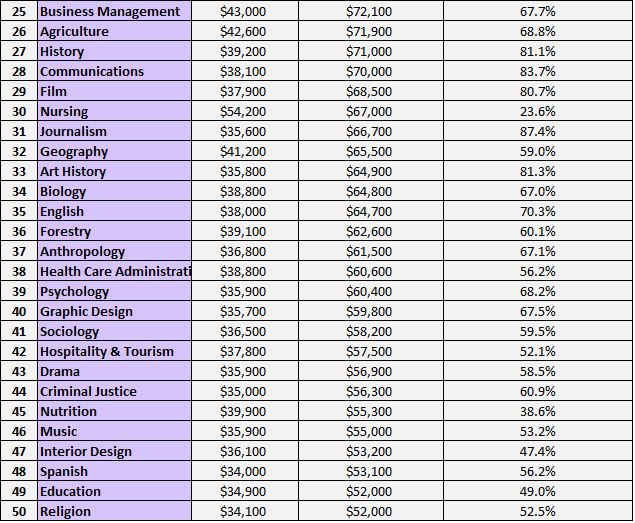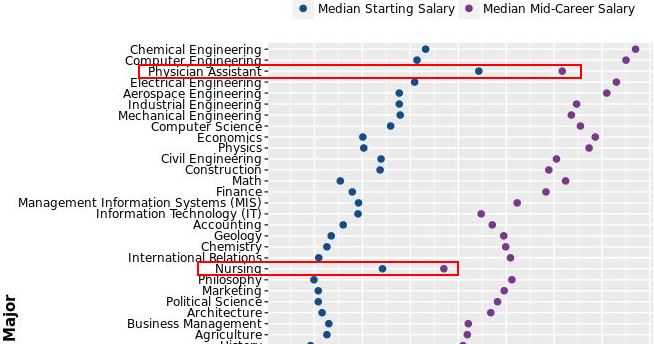
4 min read
PayScale recently completed a year-long survey of 1.2 million people with only a bachelor’s degree to find information on salaries based on undergraduate major.
I decided to dig into the data myself. Here’s what I found…
This chart shows the median starting salary and median mid-career salary according to undergraduate major:

Only fifty distinct majors are shown here, so you may not see your specific undergraduate major listed. For example, I majored in statistics, which isn’t shown here likely because there aren’t enough stats majors to collect data on.
Here are the specific salaries shown in the chart, ranked in descending order by mid-career median salary:


Some Interesting Observations
It’s interesting to see that Physician Assistant undergrad majors have the highest starting salary ($74,300), yet the second lowest percentage growth from starting to mid-career median salary ($91,700).
Similarly, Nursing majors have a fairly high starting salary ($54,200) but the lowest percentage growth from starting to mid-career median salary ($67,000).

The majors with the highest mid-career salaries are dominated by engineering fields. Chemical engineering ($107k), computer engineering ($105k), electrical engineering ($103k), and aerospace engineering ($101k) round up the top four. These four majors also account for four out of the top five starting median salaries.

The majors with the highest percentage change from starting to mid-career salary include math (103.5%), philosophy (103.5%), international relations (97.8%), economics (96.8%), and marketing (95.1%).

In general, I wasn’t surprised by the fact that engineering majors have both high starting and mid-career salaries.
I did find it surprising that nursing and physician assistant majors have fairly low percentage growth from starting to mid-career salaries.
I was also surprised at the percentage growth from starting to mid-career salaries for both philosophy and international relations majors.
Feel free to explore the data further yourself in this Excel spreadsheet.
- The Ad Revenue Grid - August 6, 2021
- Attract Money by Creating Value for a Specific Audience - July 13, 2021
- The 5-Hour Workday - March 26, 2021
Full Disclosure: Nothing on this site should ever be considered to be advice, research or an invitation to buy or sell any securities, please see my Terms & Conditions page for a full disclaimer.

I have a few questions about those figures (and since they aren’t yours, I realize you don’t have the answers). First, do these figures look at all graduates in those fields, or just those who stayed in the field. In other words, that $66,700 salary for Journalism majors–does it include those who are waiting tables, or selling phones, along with those who are writing–or is that the mid-career salary for a journalist? Your note on philosophy majors–by mid-career those who are still in the philosophy field are probably doing well as tenured faculty. Is that the reason for the growth, or does it mean that philosophy majors are able to get good jobs no matter what the industry?
Those are great questions and I wondered about them myself, Rann. As you noted, I don’t have the answers for these questions, I just took the data available, which originally came from the Wall Street Journal here: http://online.wsj.com/public/resources/documents/info-Degrees_that_Pay_you_Back-sort.html
And that, along with being a nerd, is exactly why I chose to be a chemical engineer!
Great chart. Nursing and Physician Assistant popped out to me right away. Must be frustrating to hit income ceilings in those professions.
-RBD
Agreed, those popped out to me as well. It’s interesting to see how low the mid-salary medians are for this field. They’re also only the medians, so there are certainly people who earn more than the numbers here.